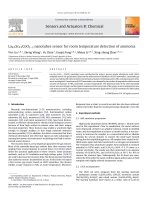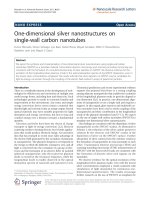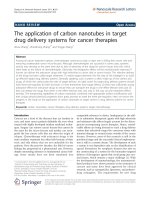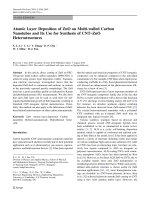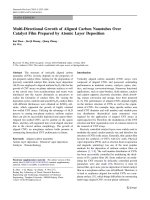Multi wall carbon nanotubes (MWCNTs) doped polypyrrole DNA biosensor for label free detection of genetically modified organisms by QCM and EIS
Bạn đang xem bản rút gọn của tài liệu. Xem và tải ngay bản đầy đủ của tài liệu tại đây (1.21 MB, 6 trang )
Talanta 80 (2010) 1164–1169
Contents lists available at ScienceDirect
Talanta
journal homepage: www.elsevier.com/locate/talanta
Multi-wall carbon nanotubes (MWCNTs)-doped polypyrrole DNA biosensor for
label-free detection of genetically modified organisms by QCM and EIS
Truong Thi Ngoc Lien
a
, Tran Dai Lam
b,∗
, Vu Thi Hong An
a
, Tran Vinh Hoang
a
, Duong Tuan Quang
c,1
,
Dinh Quang Khieu
c
, Toshifumi Tsukahara
d
, Young Hoon Lee
e
, Jong Seung Kim
e,∗∗
a
Hanoi University of Technology, Hanoi 8404, Viet Nam
b
Institute of Materials Science, Vietnamese Academy of Science and Technology, Hanoi 8404, Viet Nam
c
Hue University, Hue 84054, Viet Nam
d
Center for Nano Materials and Technology, Japan Advanced Institute of Science and Technology, Ishikawa 923-1292, Japan
e
Department of Chemistry, Korea University, Anam dong 5-1, Seongbuk gu, Seoul 136-701, Republic of Korea
article info
Article history:
Received 30 July 2009
Accepted 2 September 2009
Available online 9 September 2009
Keywords:
MWCNTs-doped polypyrrole
Electrochemical DNA biosensor
Quartz crystal microbalance
Electrochemical impedance spectroscopy
abstract
In this paper, we describe DNA electrochemical detection for genetically modified organism (GMO) based
on multi-wall carbon nanotubes (MWCNTs)-doped polypyrrole (PPy). DNA hybridization is studied by
quartz crystal microbalance (QCM) and electrochemical impedance spectroscopy (EIS). An increase in
DNA complementary target concentration results in a decrease in the faradic charge transfer resistance
(R
ct
) and signifying “signal-on” behavior of MWCNTs-PPy-DNA system. QCM and EIS data indicated that
the electroanalytical MWCNTs-PPy films were highly sensitive (as low as 4 pM of target can be detected
with QCM technique). In principle, this system can be suitable not only for DNA but also for protein
biosensor construction.
© 2009 Elsevier B.V. All rights reserved.
1. Introduction
In recent years, there has been considerable interest in the
development of DNA sensors thanks to their numerous applica-
tions such as the analysis of unknown or mutant genes, diagnosis of
infectious agents in various environments and detection of analytes
(drugs, pollutants, etc.). Traditional methods for DNA detection,
based on the radioisotopic and fluorescent detection, are labor and
time consuming, and are, thus, not well suited for routine and rapid
medical analyses, particularly for point-of-care tasks. Among some
new approaches to DNA detection, electrochemical detection has
many advantages such as the reduction of the assay time, simple
protocol and therefore can be used for on-site monitoring. In this
context, oligonucleotides (ODN, a short fragment of DNA) immobi-
lization at an electrode surface has been used in the most studies
[1–4].
Among known conducting polymers, polypyrrole (PPy) is most
frequently used in the commercial applications due to the high con-
ductivity, long-term stability of its conductivity and the possibility
∗
Corresponding author. Tel.: +84 439948160; fax: +84 437564996.
∗∗
Corresponding author. Tel.: +82 2 32903143; fax: +82 2 32903121.
E-mail addresses: (T.D. Lam),
(J.S. Kim).
1
Tel.: +84 543826359; fax: +84 543825824.
of forming homopolymers or composites with optimal mechanical
properties. PPy offers potential applications in the domain of com-
posite materials, tissue engineering, actuators, supercapacitors,
electronic and electro optic devices [5–9]. Especially, functionalized
PPy polymers have attracted great attention in label-free detection
because of their surface functionality and electron transduction
[10]. On the other hand, carbon nanotubes (CNTs) have attracted
considerable studies since their discovery [11]. They display high
electrical conductivity, good mechanical strength and excellent
chemical stability. The ability of CNTs-modified electrodes to pro-
mote electron-transfer reactions has been reported in connection
with many important biomolecules [12,13].
Therefore, the combination of conducting polymer with CNTs
was a good idea and in reality it was proven to have enhanced
charge density, electrical conductivity and electrocatalytic activity
compared with each pure component [14–16].
Recently, agricultural enterprises in the world have developed
new plant varieties by adopting modern biotechnology, including
genetic transformation. In the US, more than 40% of the corn, 50%
of the cotton and >45% of soybean acres planted in 1999 have been
genetically modified; at least 60% of food production US supermar-
kets contain genetically modified organisms (GMOs) [17]. A GMO
is referred to as a living organism whose genome has been modi-
fied by the introduction of an exogenous gene able to express an
additional protein that confers new characteristics, i.e. herbicide
tolerance [18–20].
0039-9140/$ – see front matter © 2009 Elsevier B.V. All rights reserved.
doi:10.1016/j.talanta.2009.09.002
T.T.N. Lien et al. / Talanta 80 (2010) 1164–1169 1165
The exogenous DNA that has been integrated into a crop con-
sists of a promoter (P), a structural gene (‘encoding region’) and a
transcription terminator (T). Two particular sequences are inserted
in most of the available transgenic products: the promoter of the
subunit 35S of ribosomal RNA of Cauliflower mosaic virus (35S) and
the Terminator of nopaline synthase (NOS) gene from Agrobac-
terium tumefaciens. In particular, they are widely used for the
production of many transgenic vegetables commercially avail-
able, as Roundup Ready soy, MaisGard maize and the Flavr Savr
tomato. Thus, the 35S and NOS sequences are the most frequently
used targets for GMO screening in DNA detection approach (this
approach is more often used than the second one of protein detec-
tion because DNA stability is much higher than that of proteins
and therefore DNA detection can be used for both raw and pro-
cessed materials while protein detection is suitable only for raw
materials).
On the need of fast and sensitive analytical methods for GMO
screening, in this study, we described the setup of a novel DNA
label-free electrochemical biosensor for GMO (soybean) detection,
based on MWCNT-doped PPy matrices for ODN immobilization and
hybridization.
2. Experimental
2.1. Chemicals
Pyrrole (Py) 99% were purchased from Sigma–Aldrich. It was dis-
tilled under reduced pressure before use. Other reagents used were
of analytical grade or the highest commercially available purity and
used as supplied without further purification. The multi-wall car-
bon nanotubes (MWCNT, ∼95% purity), prepared by the Chemical
vapor deposition method, were obtained from Nanolab (China). The
diameter of MWCNT is in the range of 40–60 nm and with a length
of 1–2 m. All aqueous solutions were prepared using Milli-Qwater
(18 M cm).
2.2. Functionalization of MWCNT with carboxylic groups
The functionalization of CNTs has been achieved by an oxi-
dation process, which involves extensive ultrasonic treatment in
a mixture of concentrated H
2
SO
4
/HNO
3
. The ends and sidewalls
of the treated CNTs are mainly decorated with carboxyl groups.
CNTs functionalized in this manner obtain good solubility in water
and retain their primary electronic and mechanical properties
[21].
A calculated amount ofMWNTs was added into 3:1 H
2
SO
4
/HNO
3
mixture, then ultrasonicated in a water bath for several hours at
40
◦
C. The resulting suspension was diluted with deionized (DI)
water and was centrifuged. The pretreated MWNTs (functional-
ized cMWCNT) were then washed with DI water for several times,
treated with 0.1M NaOH (to reach pH of 7), filtered, and dried at
60
◦
C overnight. The desired amount of the cMWCNTs (3 mg ml
−1
)
was added in DI water and ultrasonicated for about 15 min to form
a uniform cMWCNTs black solution.
2.3. ODN sequences
In this study the herbicide-resistance RR soybean (product of
Monsanto Inc.) has been chosen as a model. In this genome, pro-
moter sequence is found as the CaMV 35S, which is extracted from
Cauliflower mosaic virus. The synthesized ODN probe-pyrrole, non-
complementary and complementary targets were purchased from
Invitrogen. Their sequences were listed in Table 1. The PCR ampli-
fication of ODN 35S probe and its complementary target were
presented in Fig. 1.
Table 1
Composition of PBS buffer and sequences of used ODN probe and targets (comple-
mentary and non-complementary strands).
Materials Composition/sequence
PBS buffer 0.14 M NaCl; 2.7 mM KCl; 10 mM Na
3
PO
4
;
1.7 mM K
3
PO
4
;pH7.4
ODN probe (P35S) 5
GGCCATC GTTGAAGATGCCTCTGCC 3
ODN target CaMV 35S
promoter (complementary
target)
5
GGCAGAGGCATCTTCAACGATGGCC 3
2-Base non-complementary
target (NC target)
5
GGCAGAGGCAA
CTTCAAGGATGGCC 3
2.4. Electrosynthesis of films
Pure PPy film (denoted as PPy) was electrochemically deposited
on the Au microelectrode either at a constant potential and time
(+0.7 V vs. Ag/AgCl for 30 min or by voltammetric cycling from 0 to
0.9 V vs. Ag/AgCl for 30 scans, with the scan rate of 20 mV s
−1
) from
electrolytic solution containing PBS buffer, Py (0.3 M).
Probe immobilized PPy films (PPy-ODN) and probe immobi-
lized CNT-doped PPy (C-PPy-ODN) films were obtained with the
same procedure as described above with addition of ODN probe
(1 lml
−1
) and mixture of ODN probe (1 lml
−1
) and cMWCNTs
(3 mg ml
−1
), respectively, followed by the action of ultrasonica-
tion.
2.5. ODN hybridization
For hybridization experiments, a set of ODN targets (1 lml
−1
)
was used: CaMV 35S as complementary target, and 2-base muted
sequence, non-complementary (NC) target as a control. The
hybridization experiments were performed in PBS buffer (pH 7.4)
containing target strand for 30 min or 1 h at room temperature
followed by an adequate rinse with the same buffer solution.
Fig. 1. The amplicon obtained by the PCR of ODN probe (P35S, left band) and its
complementary target (right band).
1166 T.T.N. Lien et al. / Talanta 80 (2010) 1164–1169
Fig. 2. Schematic representation of working interdigitated microelectrode.
2.6. Quartz crystal microbalance (QCM)
The quartz crystals employed in this study were sputtered
AT-cut type (13.67mm diameter) with Au electrodes (5.1mm in
diameter), nominal frequency (5 MHz) with Stanford QCM 200 fre-
quency analyzer. Frequency variations are related to mass change
following the Sauerbrey equation: f =−(2/)f
2
0
(m/S). The
sensitivity is an experimental value determined by the construc-
tor. is the quartz density and its frequency coefficient. QCM
measurements enable the detection of the variation of attached
mass through the modification of the quartz crystal frequency
to occur. Under the condition of linear behavior, occurred when
the mass variation m is lower than some gcm
−2
, the mass
uptake is directly proportional to minus the frequency variation
f through an experimental factor determined by the following
calibration equation: m/f = −1.1 × 10
−9
gHz
−1
. Regarding the
aforementioned sensitivity, the QCM offers the ability to detect the
hybridization of the immobilized ODN probes with the ODN targets
(Table 2).
2.7. Electrochemical measurements
All electrochemical experiments in this work were performed
using Autolab PGSTAT 12 system (EcoChemie B.V., Utrecht, The
Netherlands). A conventional three-electrode cell was employed.
Working electrode (WE) was either Au or Pt comb-type micro-
electrodes (Fig. 2) (in electrochemical experiments) or quartz (in
QCM experiments). Pt foil was employed as the counter electrode
(CE) and Ag/AgCl 3 M KCl was used as a reference electrode (RE).
The electrolyte and the monomer (pyrrole) were mixed together to
form a solution and then the solution was purged with nitrogen for
10 min to remove oxygen from the solution.
Electrochemical impedance spectroscopy (EIS) measurements
were performed in the frequency range 200 kHz to 100 MHz using
5 mV alternating voltage superimposed on DC potential. Before
each measurement, the same constant was imposed as a pretreat-
ment for 120 s (Table 3).
Fig. 3. Cyclic voltammograms during electropolymerization of C-PPy-ODN film.
3. Results and discussion
3.1. Film formation and morphology
Normally, sensitivity and reproductibility of DNA sensors are
determined by the surface chemistry of the recognition interface,
therefore immobilization of DNA probe on solid surfaces is the pri-
mary issue for DNA sensor construction. In our case, ODN probe
immobilization was carried out via copolymerization of pure Py
monomer with ODN modified Py moieties (Py-ODN) according to
the following reaction:
The cyclic voltammograms during film formation were pre-
sented in Fig. 3. The WE consists of two electrode pairs, called
measuring and reference one, made of Pt thin film, sputtered on
a silicon wafer of which the surface was oxidized. The thickness of
the metal electrode is about 150 nm. The use of this couple of elec-
trodes is aimed at eliminating the change of charges in solution
allowing the improvement of the signal to noise (S/N) ratio of WE.
Morphologies of pure PPy, PPy before and after hybridization with
ODN were presented in Fig. 4: from left to right are SEM images of
pure PPy, PPy-ODN and C-PPy-ODN, respectively.
3.2. Label-free detection of CaMV 35S complementary target by
QCM measurements
The hybridization events with complementary and muted tar-
gets were detected by QCM and EIS. QCM is known to provide
Table 2
Frequency variation on C-PPy-ODN films vs. CaMV 35S concention during hybridization experiments.
CaMV 35S concentration (pM) Frequency (kHz) CaMV 35S concentration (pM) Frequency (kHz) CaMV 35S concentration (pM) Frequency (kHz)
0 2803.620 39 2728.606 81 2671.772
4 2798.995 43 2711.519 96 2668.262
9 2794.660 46 2706.566 117 2663.669
13 2790.531 49 2699.414 134 2659.030
17 2787.518 52 2693.783 164 2654.393
21 2784.145 56 2687.886 195 2646.078
25 2780.431 59 2683.734 224 2640.364
28 2776.974 62 2681.768 251 2636.650
32 2771.526 65 2678.836 296 2634.700
36 2746.940 70 2676.459
T.T.N. Lien et al. / Talanta 80 (2010) 1164–1169 1167
Fig. 4. SEM images of PPy (left), C-PPy (middle) and C-PPy-ODN (right).
Fig. 5. QCM graph of frequency vs. time during CaMV 35S (complementary target) injection on C-PPy-ODN electrode surface. ODN target concentration varies from1upto
300 pM.
extremely sensitive mass variation because of its resonance fre-
quency decrease upon the increase of a given mass on the quartz
crystal. Therefore, QCM is a direct and sensitive tool to assess the
immobilization of biomolecules and to evaluate their affinity to
react with complementary ones in certain specific biochemical
reactions [22]. Fig. 5 shows the resonance frequency variation of
a quartz electrode modified with C-PPy-ODN during the hybridiza-
tion with CaMV 35S complementary strand. It can be seen from
these graphs that ODN hybridization did occur at as low as 4 pM
of target concentration, corresponding of mass variation of ca.
Fig. 6. QCM graph of frequency vs. time during CaMV 35S injection on ODN probe-free C-PPy film (left) and NC target (non-complementary) injection on C-PPy-ODN electrode
surface (right) (blank experiments).
1168 T.T.N. Lien et al. / Talanta 80 (2010) 1164–1169
Fig. 7. EIS spectra of C-PPy-ODN films during hybridization with CaMV 35S sequence. Frequency range: 200 kHz to 100 mHz, E
AC
=5mV,E
DC
= 0.32 V vs. Ag/AgCl.
100 gcm
−2
. The frequency continued to fall with increasing
injection volume of target. The saturation can be reached at con-
centration of 300 pM of target. In order to validate the transduction
effect the first blank experiment with the injection of two-base
mutative non-complementary (NC) target on C-PPy-ODN film and
the other control of injection of complementary CaMV 35S on C-
PPy film (without ODN probe!) have been carried out. In these two
control experiments, the injection did not induce any frequency
variation but only a slight destabilization of the quartz. It clearly
demonstrated that the resonance frequency variation in case of
CaMV 35S sequence injection on C-PPy-ODN film was uniquely due
to hybridization (Fig. 6).
3.3. Direct detection of CaMV 35S complementary target by EIS
measurements
EIS spectra were obtained at open circuit potential. For each
set of experiment (each electrode) tree spectra were recorded
T.T.N. Lien et al. / Talanta 80 (2010) 1164–1169 1169
Table 3
Kinetic parameters, fitted with Randles model.
CaMV 35S concentration
(pM)
R
s
a
( cm
2
)
R
ct
( cm
2
)
CPE
(Fcm
−2
)
N
2
(×10
−4
)
0 500 2525.0 0.2 0.85 2.6
25 500 1717.5 0.35 0.88 3.5
28 500 767.5 0.76 0.95 2.6
32 500 457.5 0.63 0.94 3.2
36 500 347.5 0.5 0.85 2.2
39 500 119.5 2.4 0.66 2.0
42 500 95.7 3.14 0.65 3.1
46 500 71.2 3.00 0.61 2.6
49 500 71.2 1.10 0.54 2.8
52 500 70.0 1.64 0.51 2.4
56 500 67.0 1.54 0.49 3.6
59 500 61.2 1.53 0.47 3.2
62 500 60.0 1.43 0.44 2.8
65 500 69.5 0.82 0.48 4.1
70 500 75.0 0.56 0.54 4.6
81 500 75.0 0.60 0.34 5.6
a
R
s
was fixed at 500 cm
2
.
corresponding to pre-ODN probe immobilization, the post-ODN
probe immobilization and post-hybridization with ODN targets
events, respectively. EIS Nyquist plot spectra were shown in Fig. 7.
Simulated values of kinetic parameters were derived from EIS
experimental data by fitting an equivalent circuit model based on
Randles model [23]. Thisequivalent circuit includes a solution resis-
tance (R
s
); a constant phase element (CPE); and the charge transfer
resistance (R
ct
). The CPE reflects inhomogeneities of the surface
layer and the substitution of the double layer capacitance with a
CPE improved the adequateness of fitting. The parameter n deter-
mines the extent of the deviation from the Randles model. When
n = 1, 0 and 0.5 the CPE represents an ideal capacitor, pure resis-
tor and Warburg element, respectively. The values of the fitted
parameters were given in Table 3. Small values of
2
in the range
of low CaMV 35S target concentration (from 25 to 80 pM) suggest
that this Randles model fit the experimental data quite well in
this low range of concentration. Furthermore, the value of 1/R
ct
is linearly proportional to the target concentration according to
the following equation: 1/R
ct
(
−1
) = 0.32 × 10
−4
× C − 0.3 × 10
−3
(pM). In the higher (than 81 pM) concentration data the fitting
with Randles model encountered big error, related to the diffu-
sion element of Redox probe (n approaches 0.5). For this reason
Vorotyntsev’s model [24] was considered to be used for a high
range of concentration (96–296 pM) (Fig. 8). Previously, this model
was successfully applied for quinone-containing conducting poly-
mers [25] Vorotyntsev’s model choice for our C-PPy-ODN system
was rationalized on the similar “signal-on” behavior (i.e. decrease
of R
ct
during hybridization, firstly reported by Pham’s group
[26,27]) of this C-PPy-ODN system to the quinone one. “Signal-
on” effect means that DNA hybridization at the vicinity of the
polymer/solution interface increases the switching rate of electron-
ically conducting polymer. According to the studies of this group,
two main explanations can be envisaged: the electrostatic effect
Fig. 8. Equivalent circuit of Vorotyntsev’s model.
and/or the steric effect due to the polyelectrolyte character of ODN
strands. Both could modify the ionic transport to and across the
polymer/solution interface [26–28]. However, the variation ten-
dency of obtained kinetic parameters for C-PPy-ODN system was
not fully interpreted and it will be subjected for the further study
and discussion.
4. Conclusions
Electrochemical DNA detection is advantageous because of its
fast performance and simple instrumentation. In this study, the
free-label DNA detection (applied for GMO) is demonstrated based
on C-PPy-ODN system. A quite low detection limit can be reached
thanks to enhanced performance of C-PPy-ODN composite mate-
rial. EIS data were well fitted with Randles model (in the low range
of DNA concentration). In the higher range of DNA concentration,
the other model, taking into account the diffusion of redox couple
is needed to simulate the experimental data. Furthermore, com-
plementary studies are necessary to interpreting all EIS values as
well as understanding the signal-on mechanism of C-PPy-ODN sys-
tem.
Acknowledgements
T.T.N. Lien wishes to thank the receipt of a grant from the Flem-
ish Interuniversity Council for UniversityDevelopment cooperation
(VLIR UOS), V.T.H. An would like to acknowledge HUT university
grant T2008-01. J.S. Kim is grateful for grant of Creative Research
Initiative program supported by MEST.
References
[1] Rajesh, T. Ahuja, D. Kumar, Sens. Actuat. B: Chem. 136 (2009) 275–286.
[2] F. Garnier, H. Korri-Youssoufi, P. Srivastava, B. Mandrand, T. Delair, Synth. Met.
100 (1999) 89–94.
[3] E. Palecek, M. Fojta, F. Jelen, Bioelectrochemistry 56 (2002) 85–90.
[4] E. Palecek, M. Fojta, Talanta 74 (2007) 276–290.
[5] M. Sun, S. Zhang, T. Jiang, L. Zhang, J. Yu, Electrochem. Commun. 10, 12 (2008)
1819–1822.
[6] R.A. Green, N.H. Lovell, G.G. Wallace, L.A. Poole-Warren, Biomaterials 29 (2008)
3393–3399.
[7] J. Oh, M.E. Kozlov, B.G. Kim, H.K. Kim, R.H. Baughman, Y.H. Hwang, Synth. Met.
158 (2008) 638–641.
[8] S. Skaarup, L. Bay, K. West, Synth. Met. 157 (2007) 323–326.
[9] T. Livache, A. Roget, E. Dejean, C. Barthet, G. Bidan, R. Teoule, Nucl. Acids Res.
22 (1994) 2915–2921.
[10] N. Lassalle, P. Mailley, E. Vieil, T. Livache, A. Roget, J.P. Correia, L.M. Abrantes, J.
Electroanal. Chem. 509 (2001) 48–57.
[11] S. Iijima, Nature 354 (1991) 56–58.
[12] V. Raffa, G. Ciofani, S. Nitodas, T. Karachalios, D. D’Alessandro, M. Masini, A.
Cuschieri, Carbon 46 (2008) 1600–1610.
[13] R.K. Gupta, V. Saraf, Curr. Appl. Phys. 9 (Suppl. 1) (2009) S149–S152.
[14] C. Peng, J. Jin, G.Z. Chen, Electrochim. Acta 53 (2007) 525–537.
[15] J.Y. Kim, K.H. Kim, K.B. Kim, J. Power Sources 176 (2008) 396–402.
[16] J.C.C. Yu, E.P.C. Lai, React. Funct. Polym. 66 (2006) 702–711.
[17] R.N. Beachy, Science 285 (5426) (1999) 335.
[18] S. Vollenhofer, K. Burg, J. Schmidt, H. Kroath, J. Agric. Food Chem. 47 (1999)
5038–5043.
[19] F.E. Ahmed, Trends Biotechnol. 20 (2002) 215–223.
[20] E. Mariotti, M. Minunni, M. Mascini, Anal. Chim. Acta 453 (2002) 165–172.
[21] J. Zhang, H. Zou, Q. Qing, Y. Yang, Q. Li, Z. Liu, X. Guo, Z. Du, J. Phys. Chem. B 107
(2003) 3712–3718.
[22] D.A. Buttry, M.D. Ward, Chem. Rev. 92 (1992) 1355–1379.
[23] J.E.B. Randles, Discuss. Faraday Soc. 1 (1947) 11.
[24] M.A. Vorotyntsev, C. Deslouis, M.M. Musiani, B. Tribollet, K. Aoki, Electrochim.
Acta 44 (1999) 2105–2115.
[25] T.D. Lam, A novel functionalized conducting polymer based DNA biosensor.
Direct electrochemical detection of hybridization, PhD thesis of Univ. Paris VII,
2003.
[26] S. Reisberg, B. Piro, V. Noël, M.C. Pham, Anal. Chem. 77 (2005) 3351–3356.
[27] S. Reisberg, L.A. Dang, Q.A. Nguyen, B. Piro, V. Noël, P.E. Nielsen, L.A. Le, M.C.
Pham, Talanta 76 (2008) 206–210.
[28] S. Reisberg, B. Piro, V. Noël, T.D. Nguyen, P.E. Nielsen, M.C. Pham, Electrochim.
Acta 54 (2008) 346–351.

